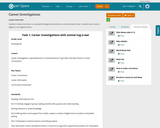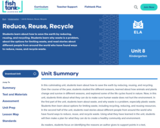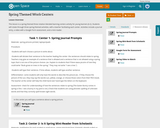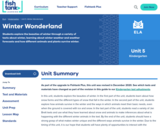
A lesson to introduce ISearch to young children. Children will research information on animals.
- Subject:
- Information, Media and Technological Literacy
- Material Type:
- Lesson Plan
- Author:
- Melanie Moore
- Date Added:
- 10/11/2019

A lesson to introduce ISearch to young children. Children will research information on animals.
![ArtsNow Learning: Self-Portraits with the Touch of a Finger [PDF]](https://openspace.infohio.org/static/newdesign/images/materials/default-thumbnail-index.png)
In this lesson, students will explore self-portraiture by looking at classical portrait paintings, such as Diego Velazquez's La Infanta Margarita or Raphael's Portrait of Baldassare Castiglione. A close look at these works reveals mathematical relationships and proper proportions that students can incorporate into their own self-portraits.

Editing is a step that can often be overlooked in Kindergarten; however, it is crucial that our students understand how and why to go back and fix their writing! In this lesson, students will take suggestions from the teacher and their peers to make needed changes in order to better their writing. Includes a printable editing checklist.

In this lesson, students will experience different types of publishing in order to strengthen their motivation and cultivate pride in their work. After utilizing the writing process, students will type out their writing on a computer. Included is a tool to help students have success using the computer, and pictures of final drafts created by the students.

Students will write a sloppy copy and help a peer to edit their writing. They will use a kid-friendly checklist (included)to help each other find their mistakes. Videos of students engaged in the lesson are provided, along with a teacher's grading rubric.

You mean I have to write my story again, have someone check to make sure it's right, and fix my mistakes? In this lesson, students will peer edit each other's writing. They will use their five-star checklists (included) to make sure they have all the components on the checklist. A video of the lesson in action and a grading rubric are included.

Bubbl.us is a free online application that allows users to brainstorm online then save them, email them and share with friends.

Practice important fine motor skills by having students control their pencil, following a line. Teacher lesson plan for K-1st.

Students create a brochure or a pamphlet designed to promote an animal related career. Students can create a digital or non-digital version.

A very useful lesson that incorporates the process of collaboration to elementary students. Students brainstorm and use prewriting strategies to write a group story.

Lesson in which students engage in an entire-group revising process, using a story which has already been written by the group. An excellent follow-up lesson to the "prewriting and drafting" lesson.

Take a walk in the forest and enjoy the trees and animals that live there. Book includes audio narration in 7 additional languages with text in English.

Lions and Tigers and Bears OH-my! Help young students practice their research and presentation skills with this fun, hands-on animal research and presentation project.

Students learn about how to save the earth by reducing, reusing, and recycling. Students learn why waste is a problem, about the options for limiting waste, and read stories about different people from around the world who have found ways to reduce, reuse, and recycle waste.

This video, effective for engaging students with significant cognitive disabilities, explores how a classroom teacher chose a topic for a writing assignment.

This lesson is a spring themed three rotation blended learning centers activity for young learners (k-2). Students will rotate through three spring themed activities, with a teacher facilitating each center. Activities include a journal entry, a video with a Google Form assessment, and a mini-reader.

Lesson which teaches elementary students the importance and significance of keeping the audience in mind when writing. Students write invitation letters and perform extension activities while learning these concepts. Good resource.

A simple book about hand tools. Includes audio narration in 11 additional languages with text in English.

In this modeled lesson, second graders work in groups to create "video dictionaries," using a tablet and an app. Students complete graphic organizers then find images online to illustrate their words. They write their own sentences, completing the project by recording their own voices and adding extras, such as backgrounds and special effects. The dictionary is placed online to share with others and refer to for future use. [4:19]

Students explore the beauties of winter through a variety of texts about winter, learning about winter weather and weather forecasts and how different animals and plants survive winter.